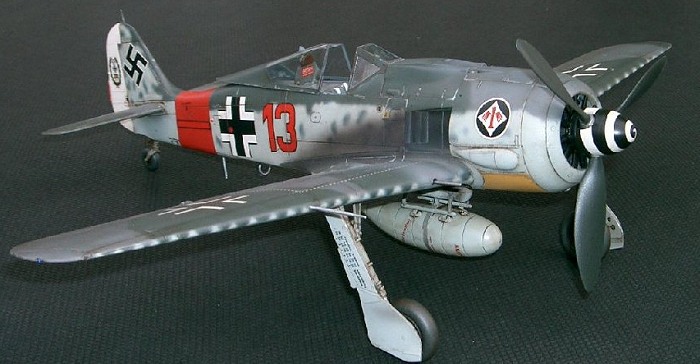
| KIT #: | 08071 |
| PRICE: | $39.95 MSRP |
| DECALS: | Two options |
| REVIEWER: | Scott Weir |
| NOTES: | Kit backdated, Eagle Strike decals and Eduard seat belts |

| HISTORY |
On 25 September 1939
Feldwebel Heinz Bar claimed his first kill while flying Bf 109E,
‘White13’of JG51. One hundred and ninety nine kills later Major Bar still
preferred the no.13 marquee for his primary mount. On 24 April 44 his 200th
victim [B-24] fell to his guns while flying his reserve aircraft, 190A7
‘RED23’. But, it was his lucky ‘RED13’ in which he emblazed on its white
fielded rudder the Knights Cross and Oak leafs encircling the milestone
number 200. One year later when the war
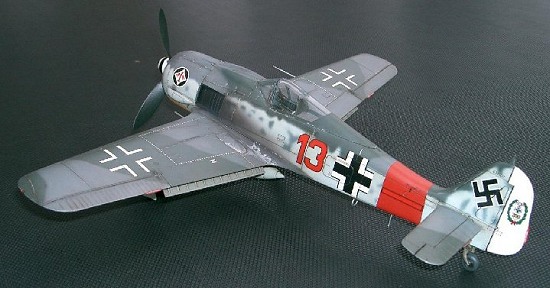 was coming to a close Oberstleutnant Heinz Bar, in command of 3/JG 2, wasn’t about to throw his
luck to the wind and finished the war in Me262--------------You guessed it,
RED13.
was coming to a close Oberstleutnant Heinz Bar, in command of 3/JG 2, wasn’t about to throw his
luck to the wind and finished the war in Me262--------------You guessed it,
RED13.
Of the approximately 20,000 FW190’s built in various models during the war the total A7 production series was comprised of only 80 aircraft. The most note worthy difference from its’A6 predecessor was the removal of the 7.92mm cowling guns in favor of the bigger MG131 13mm’s giving future modelers the endless debate over what is ‘accurate cleavage.’ Water methanol boost, additional internal fuel, relocated pitot tube and centerline rack along with other improvements over the A7 would herald in the entry of the most signifigant 190 of them all. The infamous A8.
The original intent for the A7 was to be a high speed reconnaissance bird. With the relentless onslaught of the Yanks by day and the Brits by night the necessity of war would deem otherwise.
For a much more in depth history of Heinz Bar, Tom Cleavers 1/48th Dragon FW190 [A7, RED23] review is a must read.
| THE KIT |
I’ll refer you to the preview here on MM.
| CONSTRUCTION |
As with many kits this one was
started with no end game in mind. When the cockpit, engine and wheel wells
were completed it languished on the partial build pile for a couple of
months. After obtaining some decal sheets from Eagle Strike the options of
those markings were tossed around for awhile. It wasn’t until I pulled up a
review over at Hyperscale by Brett Green and
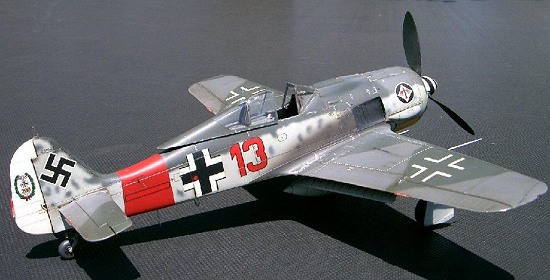 Chris Wauchop on backdating
the Hasegawa A8 to an A7 Sturmbock that the light shone through. Heinz Bars
colorful RED13 on Eagle Strike sheet# 32063 was the one. Most of their work
to send the Hasegawa kit back to an earlier model is relatively simple. It
would be even more simplified for this Wurger due to not having to
fabricate the canopy and cockpit armour they did for the Sturmbock.
Chris Wauchop on backdating
the Hasegawa A8 to an A7 Sturmbock that the light shone through. Heinz Bars
colorful RED13 on Eagle Strike sheet# 32063 was the one. Most of their work
to send the Hasegawa kit back to an earlier model is relatively simple. It
would be even more simplified for this Wurger due to not having to
fabricate the canopy and cockpit armour they did for the Sturmbock.
Few problems were encountered with the basic construction. The port wing falls a little short with the alignment of the wing root. This was corrected by stuffing some small pieces of sheet styrene between the top of the wheel well and the inside of the wing till the desired dry fit was attained. A little sanding and putty was needed for the cowling ring area. And as always there is the obligatory sanding of the wing leading edges and fuselage spine. For the most part it fits really well for a large scale kit and offers few vices.
FROM AN A8 BACK TO THE A7
1.
Heinz Bar's FW190A7 had its outboard wing armament deleted. Several of the older pilots who had been around to fly the earlier A3 still opted for maneuverability over the increased firepower and added weight. Just like Brett Green I found myself filling in the holes I’d drilled earlier for the outer gun breach covers. The underside shell ejection chutes were filed and sanded away also.
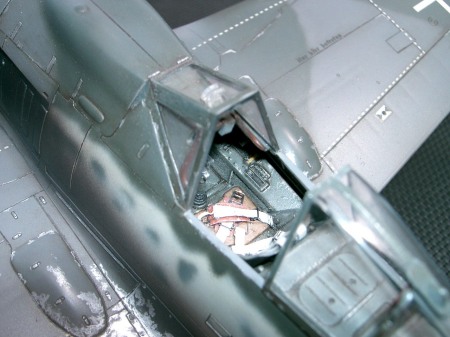 2.
2.
3.
The added weight of the A8 necessitated the centerline rack be moved forward eight inches to improve center of gravity. We’re going the other way so the locater pin hole for the front part of the rack was re drilled 4mm behind the existing one. The back section of the rack gets 4mm trimmed of the front end of it.
4.
The pitot tube is relocated from the starboard wingtip further inboard just outside from where the outboard gun muzzle would be.
5.
Brett Green noted a correction from Luftwaffe researcher John Beaman that the upper front cowling fasteners on the A7 do not all three face in the down position. This would become common to the A8. The two sets in front face up while the rear set of fasteners face downward. This is where I found myself scraping putty out of the front upper set only to turn around and fill in the lower ones.| COLORS & MARKINGS |
I don’t have any photographic reference of Maj. Bar's RED13 so the decal instructions and a little intuition would have to guide me through this phase.
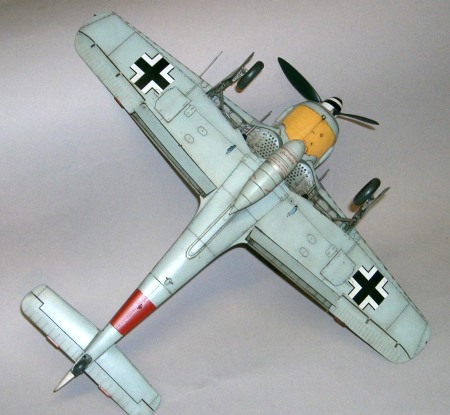 All paints used are oil
based and sprayed exclusively from a PascheVL airbrush equipped with a no.1
tip. The spinner, cooling fan and main wheels are black while the prop
blades are RLM70 black green. Wheel wells, inside gear doors and tail wheel
strut are all RLM02 grey green. It was then time to mask off the wheel
wells and engine area followed by a coat of Testors gray enamel primer. The
lower cowling is painted Testors RLM04 yellow while the rudder is sprayed
white after which they get masked off as well. The last thing to do before
camouflage is pre-shading.
All paints used are oil
based and sprayed exclusively from a PascheVL airbrush equipped with a no.1
tip. The spinner, cooling fan and main wheels are black while the prop
blades are RLM70 black green. Wheel wells, inside gear doors and tail wheel
strut are all RLM02 grey green. It was then time to mask off the wheel
wells and engine area followed by a coat of Testors gray enamel primer. The
lower cowling is painted Testors RLM04 yellow while the rudder is sprayed
white after which they get masked off as well. The last thing to do before
camouflage is pre-shading.
RLM 74, 75 and 76 are Floquil enamels. The lighter underside 76 goes on first followed by the two upper colors 74 and 75 which are lightened up a shade and also comprise the mottling. To get the tail band to match the #13 and bar decal inside the band itself a drop of brown was added to some Testors red and shot with a mask of Parafilm M. After removing the mask from the rudder, lower cowl and tail band it’s all clear coated with Plasti-Cote clear enamel. When the clear finally cures the decals are applied with a little Solvaset. After the decals set they get spliced with an Exacto #11 in the panel lines and Solvaset again to pull them in really good and tight. All this is covered in another coat of clear and set aside to cure once more. After a wash of raw umber oil paint it is clear coated for the last time to seal the wash and then dulled with Floquil dull coat. Exhaust stains are the last item to get blown on. Looking a little too pristine I borrowed Chris Wauchops silver artists pencil method to chip up the paint a bit. I was amazed at how well it worked.
| FINAL CONSTRUCTION |
This is all wrapped up with the installation of the landing gear, tires, door covers and wingtip formation lights. Eduard seatbelts were installed and she’s all done with the exception I’d like to add some treaded tires from Eagle editions down the road.
| CONCLUSIONS |
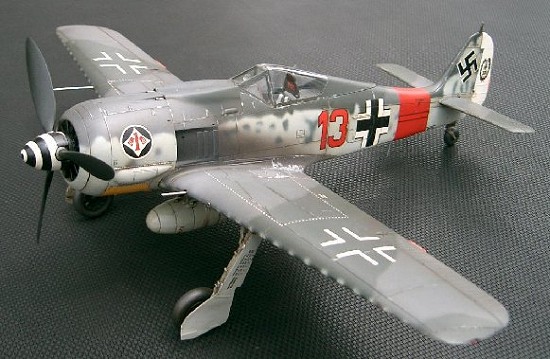 I never thought we’d
see the resurgence of 1/32nd kits as we have in the past few
years. It seemed that there was only a faint pulse of interest for the
larger scales through the eighties and nineties. After Hasegawa started to
release their 109 line a couple years back Trumpeter jumped on board with
some of the most [occasionally flawed] ambitious toolings I’ve seen to
date. It hasn’t rained big scale styrene like this in over thirty years.
Hopefully the drought is over for good!
I never thought we’d
see the resurgence of 1/32nd kits as we have in the past few
years. It seemed that there was only a faint pulse of interest for the
larger scales through the eighties and nineties. After Hasegawa started to
release their 109 line a couple years back Trumpeter jumped on board with
some of the most [occasionally flawed] ambitious toolings I’ve seen to
date. It hasn’t rained big scale styrene like this in over thirty years.
Hopefully the drought is over for good!
The release of the all new tool 1/32nd FW190 A8 a year ago and more recently A5 have spawned reviews like a family of rabbits. That speaks volumes. It is a quantum leap from the old 1/32nd standard 190 of the early 70’s for which I’ve also built. Hasegawa's simple but versatile approach to engineering is spot on. Without a doubt this is the finest series of FW190 kits currently available in my opinion. If were lucky there’ll be an A1,2,3 and 4 in the pipeline!!!!!!!!!!!
Thanks to Tom Cleaver and to the boys over at Hyperscale for some inspiring builds and insightful reviews. I’m an old dog, but never too old to learn.
| REFERENCES |
1. Squadron Signal----- Focke Wulf 190A Walkaround
2. Squadron Signal----- Focke Wulf 190 In Action
3. Osprey---------------- Focke Wulf FW190 Aces of the Western Front
May 2005
If you would like your product reviewed fairly and fairly quickly, please contact the editor or see other details in the Note to Contributors.